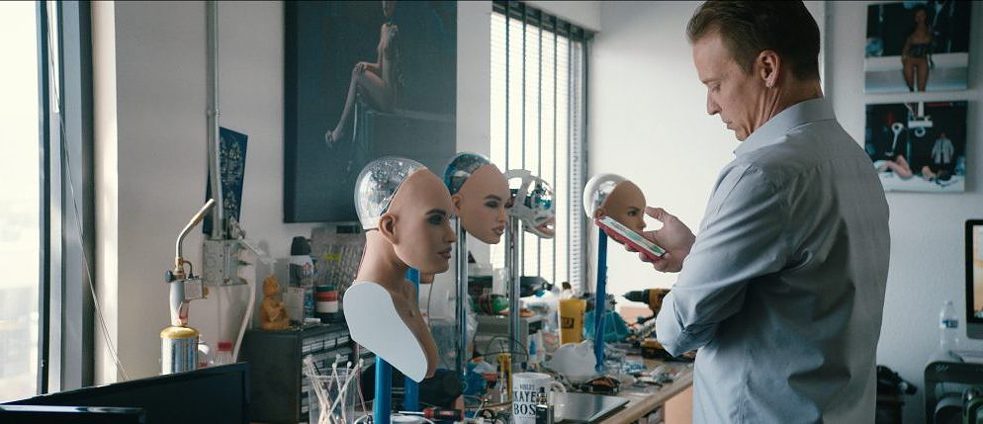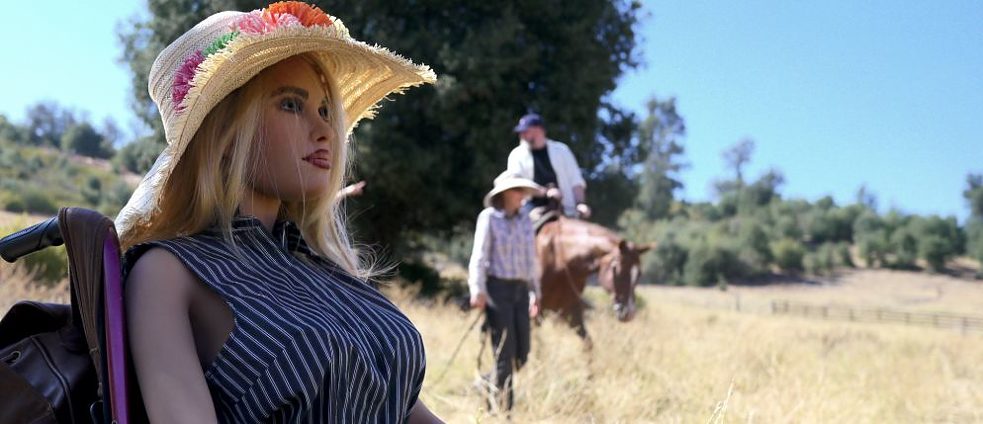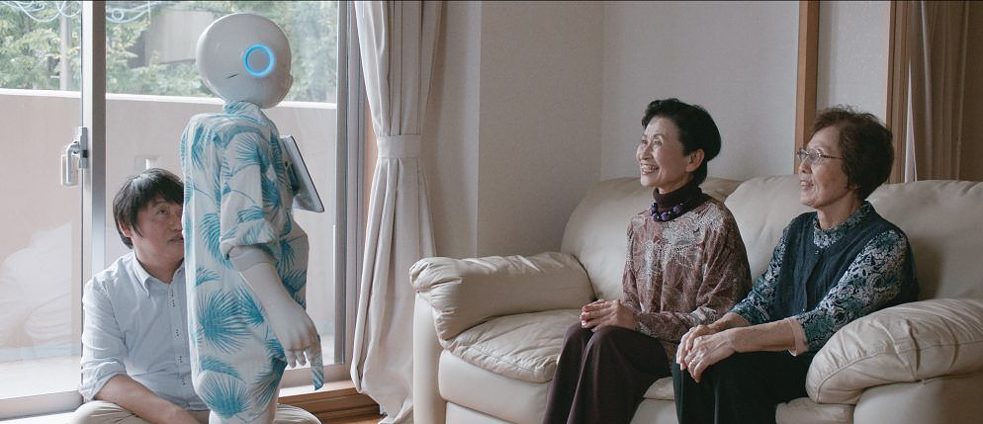BIFF 2019
Hi, AI: A window into the future - and ourselves

When Chuck takes Harmony on a road trip in his campervan, he’s just an average American guy trying to romance the object of his affection. When Sakurai chats with Pepper about her day, she’s an ordinary Japanese grandmother talking with an energetic, easily distracted child. Unremarkable in their tone and content, these kinds of interactions occur everyday; however, in Hi, AI, they provide a window into the future. While Chuck and Sakurai are firmly comprised of flesh and blood, their companions are made of metal and microchips — no matter how close a resemblance they might be designed to bear to humanity.
By Sarah Ward
As played out in noticeably standard scenes, watching a man woo his android date and a matriarch connect with her robotic pseudo grandson makes for intriguing viewing. In her third documentary (after 2009’s Pornoprotokolle and 2013’s Away From All Suns), German director Isa Willinger isn’t concerned with the technical specifications, but the human applications — how people react to their computerised counterparts, what role androids might play in our lives moving forward and, crucially, what we want from them. An observational film presented without talking heads, Hi, AI nonetheless provides some overarching guidance, courtesy of audio snippets from Sam Harris’ Making Sense podcast. In his episode featuring Massachusetts Institute of Technology robot ethics expert Kate Darling, the pair encapsulate the movie’s central thesis perfectly, explaining how we place expectations on artificial intelligence as if it were human. Via the documentary’s intertwined vignettes, Willinger then demonstrates this notion.
REVEALING INTERACTIONS
It’s there in the twinkle of Chuck’s eyes as he treats Harmony as he would any real-life woman — or perhaps better, given his history. Behind his considerable size and bearded face lurks a man grappling with the aftershocks of a painful childhood, and with the post-traumatic stress disorder it caused, ensuring that relating to others is a difficult task. Of course, it doesn’t escape attention that Harmony is a life-sized doll who, although installed with artificial intelligence that responds to Chuck’s conversational patter in a light Scottish accent, visually resembles a sex toy. For viewers, seeing the pair interact can be disconcerting as a result. He regards her as he would someone who’s breathing, but with her appearance and simplistic answers (and worse, her submissive, placating turns of phrase, which sound like they’ve been ripped from a male fantasy), she couldn’t be more fake. 'Harmony' goes on a road trip
| © Hi, AI
Sakurai also treats Pepper as she might any real grandchild, to a point. Thanks to his gleaming white exterior, glowing eyes and speakers for ears, Pepper doesn’t look remotely human; however, perhaps because he’s designed with a pre-teen rather than an adult in mind, his temperament and personality feel authentic. Accordingly, it’s with a bemused, grandmotherly air that Sakurai explores the android’s conversational capabilities — with Pepper the result of her son’s work, then brought home to the family for testing. She tries to tell him about her day, and he keeps bringing the conversation back to himself. When her daughter-in-law tells Pepper that she’s leaving for a few minutes, he insists that she stay so that he can tell a joke. In every exchange, Pepper imitates a child who’s curious about the world, demands attention and lingers on the cusp of throwing a tantrum to get what he wants.
'Harmony' goes on a road trip
| © Hi, AI
Sakurai also treats Pepper as she might any real grandchild, to a point. Thanks to his gleaming white exterior, glowing eyes and speakers for ears, Pepper doesn’t look remotely human; however, perhaps because he’s designed with a pre-teen rather than an adult in mind, his temperament and personality feel authentic. Accordingly, it’s with a bemused, grandmotherly air that Sakurai explores the android’s conversational capabilities — with Pepper the result of her son’s work, then brought home to the family for testing. She tries to tell him about her day, and he keeps bringing the conversation back to himself. When her daughter-in-law tells Pepper that she’s leaving for a few minutes, he insists that she stay so that he can tell a joke. In every exchange, Pepper imitates a child who’s curious about the world, demands attention and lingers on the cusp of throwing a tantrum to get what he wants.
EXPLORING TECHNOLOGY — AND OURSELVES
Willinger starts Chuck and Sakurai’s stories with a clear acknowledgement, ensuring that Harmony and Pepper’s artificial nature — and their context — are apparent from the outset. In Chuck’s case, we see him collect Harmony from the lab where she was manufactured, and even learn how to remove her head for ease of transport (while standing in a room with at least one suggestive image on its walls, making it plain just how some customers will deploy their new companions). The German director also allows the film’s tales to extend beyond their amusing first encounters, past their comfort zones and into awkward territory — such as when Pepper insists on asking Sakurai whether she’s attended to the household chores. If it wasn’t already obvious, this isn’t a highlights package about AI or a sales pitch spruiking its uses, but an examination of the reality of human-robotic interactions. Sakurai with robot 'Pepper'
| © Hi, AI
Moving back and forth between its segments with a near-dreamlike fluidity, Hi, AI presents other examples of artificial intelligence in action. We see dental trainees attend to the teeth of humanoid androids in order to learn their trade, and bear witness as robotic concierges provide directions and greet customers. In less lifelike guises, the film shows machines learning how to walk, navigate stairs and cook popcorn. Tools, employees, companions, entertainment, intimacy — AI fulfills all these roles now and will do so in the future, although just what we want from the field remains opaque. Hi, AI might not provide a definitive answer, but it inspires the right trains of thought.
Sakurai with robot 'Pepper'
| © Hi, AI
Moving back and forth between its segments with a near-dreamlike fluidity, Hi, AI presents other examples of artificial intelligence in action. We see dental trainees attend to the teeth of humanoid androids in order to learn their trade, and bear witness as robotic concierges provide directions and greet customers. In less lifelike guises, the film shows machines learning how to walk, navigate stairs and cook popcorn. Tools, employees, companions, entertainment, intimacy — AI fulfills all these roles now and will do so in the future, although just what we want from the field remains opaque. Hi, AI might not provide a definitive answer, but it inspires the right trains of thought.For decades, filmmakers have flocked to the topic, probing the intersection of organic life and artificial intelligence. They’ve pondered not only whether androids dream of electronic sheep, as Blade Runner famously asked, but the line between humans and our computerised doppelgängers. The questions have kept flowing ever since 2001: A Space Odyssey left our future at the mercy of AI, interrogating the continuum that links the first building blocks of existence to its most advanced technological reaches. AI: Artificial Intelligence contemplated a child-like robot’s ability to love, Her wondered about the connection between people and the ever-present gadgetry we’re becoming so reliant on, and Ex Machina asked not only whether we can even tell the difference between the real and manufactured, but whether the distinction matters. These movies echo through Hi, AI like prophecies coming true, with Willinger’s documentary as fascinating as its predecessors in one specific way. Whether through speculating about what might come or documenting what’s already here, to inspect the relationship between humans and AI is to lay bare our thoughts on ourselves — we are the latter’s creators, after all.
Hi, AI will be screening in October 2019 at both the Brisbane International Film Festival and the Antenna Documentary Film Festival in Sydney.